Physical Address
304 North Cardinal St.
Dorchester Center, MA 02124
Cephaloceles are cranial defects along bony sutures in which there is a herniation of the brain and/or meninges. Cephaloceles can be occipital, parietal, or frontal; in the Western Hemisphere, 80% are occipital. If the cephalocele sac contains brain tissue, it is termed an encephalocele ; if only cerebrospinal fluid (CSF) is present, it is termed a meningocele .
Incidence ranges from 1:3500 to 1:5000 live births. Occipital encephalocele is most common.
Usually isolated, but in a small percentage of cases may be a part of a chromosomal or nonchromosomal syndrome.
The exact pathogenesis of cephalocele is unclear. However, there is failure of closure of the neural tube no later than 26 days after conception, at the time when the anterior neural tube closes.
Prenatal diagnosis at 11 0/7–13 6/7 weeks is possible, and the sonographic appearance is similar to that described during the second trimester.
Saclike structure adjacent or posterior to fetal head
Brain tissue seen in sac covered by skin
Skull defect
Hydrocephaly in 80% of occipital encephaloceles
Microcephaly (20%)
Midline scalp masses, such as cysts, hemangiomas, nuchal tumors, cephalohematomas, cystic teratomas, scalp edema, cystic hygromas, branchiogenic cysts, and fetal hair (during the third trimester)
Amniotic band syndrome
Autosomal recessive syndromes that feature a cephalocele: Meckel syndrome (cephalocele, renal cystic dysplasia, and postaxial polydactyly); Walker-Warburg or HARD ± E syndrome ( h ydrocephaly, a gyria, r etinal d ysplasia, with or without e ncephalocele); and Knobloch syndrome (vitreoretinal degeneration and occipital encephalocele)
Approximately 65% of fetuses and infants with cephalocele have at least one additional major malformation, whereas 35% have isolated cephalocele.
Extracranial malformations: cardiovascular (ventricular septal defect [VSD], coarctation of the aorta, single umbilical artery); urogenital tract (urinary tract dilatation [pyelectasis], ureteral agenesis); malformations of the extremities (talipes equinovarus); malformations of the thorax and abdominal wall (gastroschisis, diaphragmatic hernia, costal malformations).
CNS anomalies include microcephaly (up to 25%), hydrocephaly (30%–50%), agenesis of the corpus callosum, Dandy-Walker malformation, holoprosencephaly (lobar), Arnold-Chiari type II malformation, and cerebral dysgenesis.
Trisomy 18, trisomy 13, mosaic trisomy 20; various deletions and duplications also described.
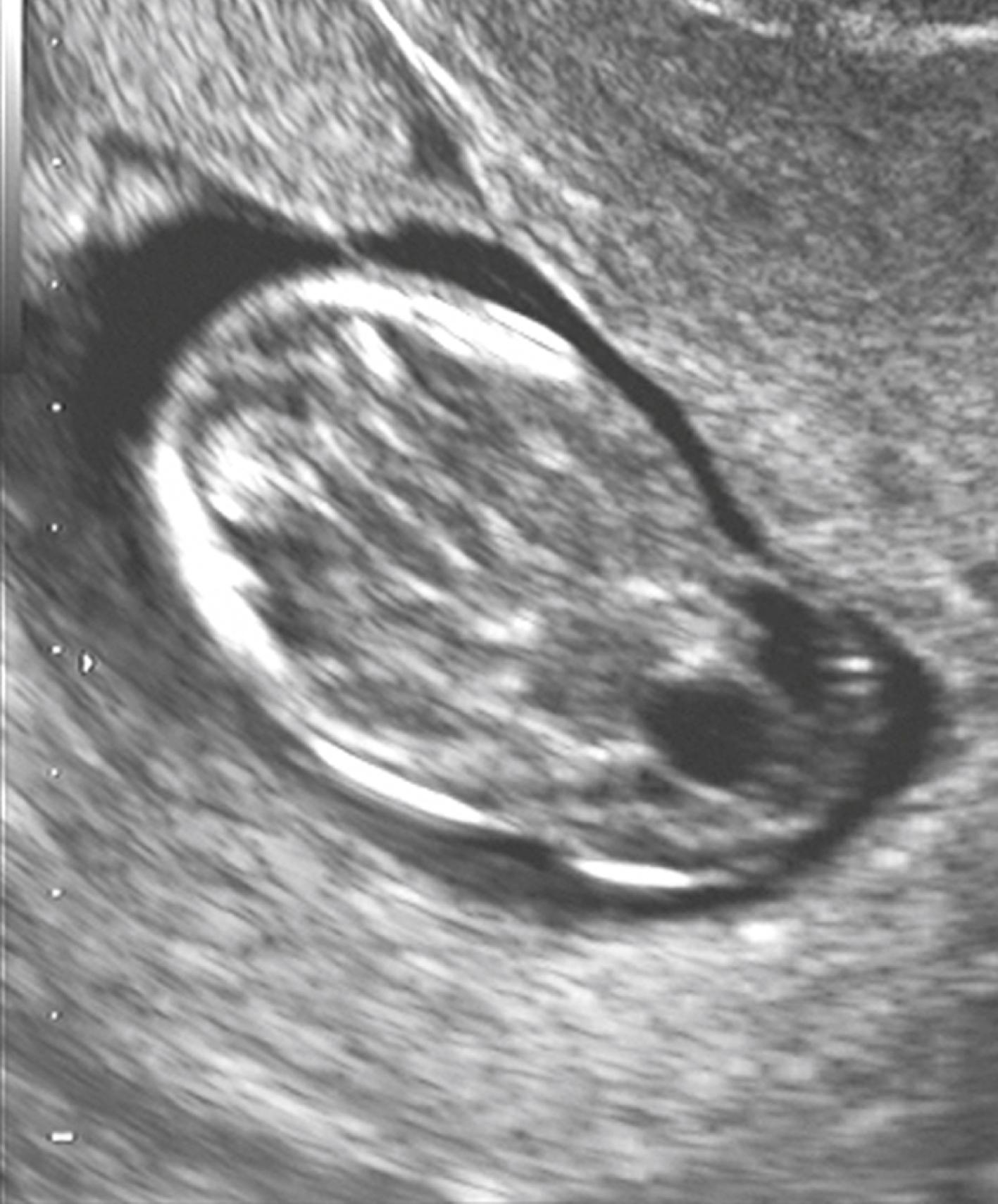
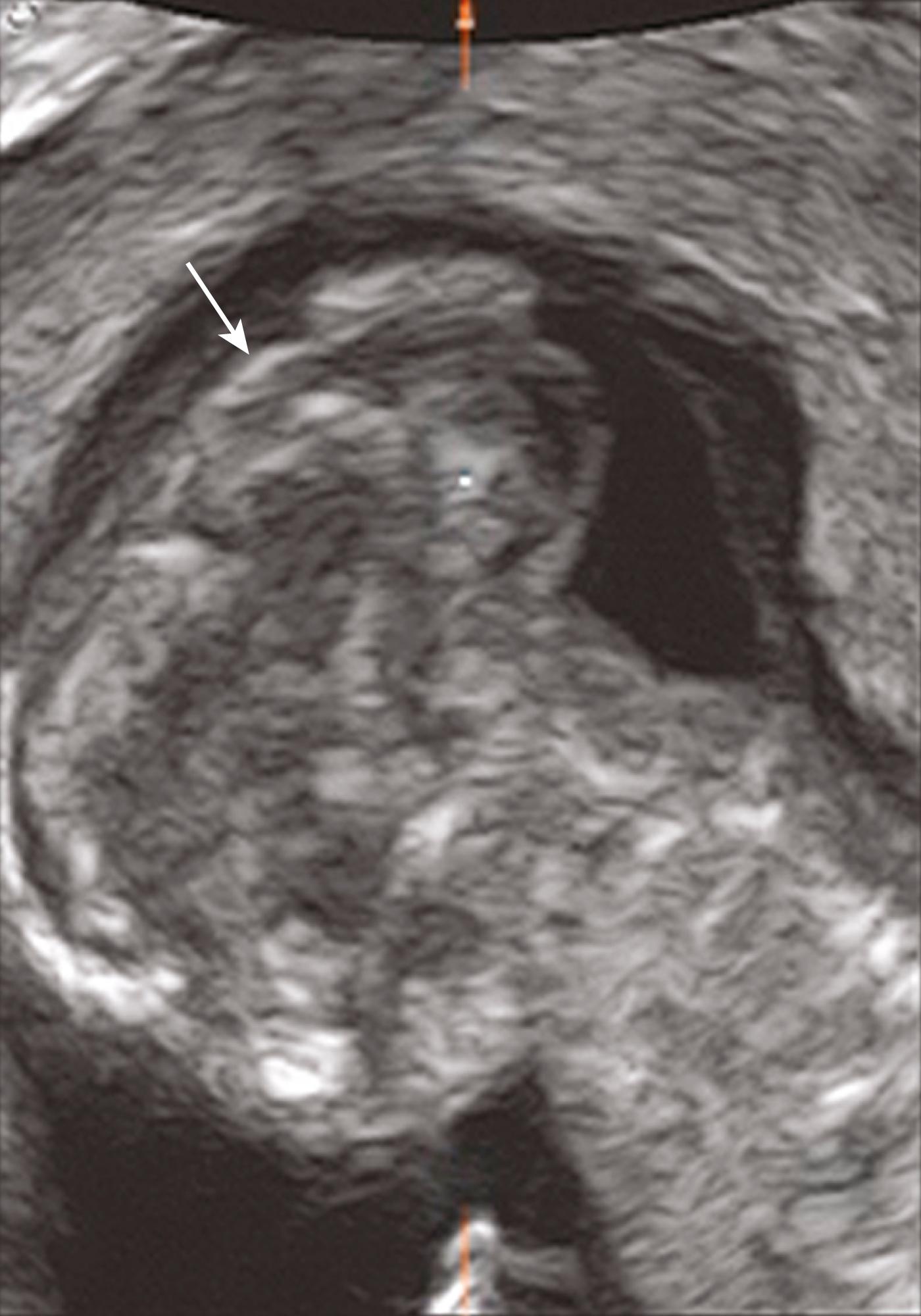
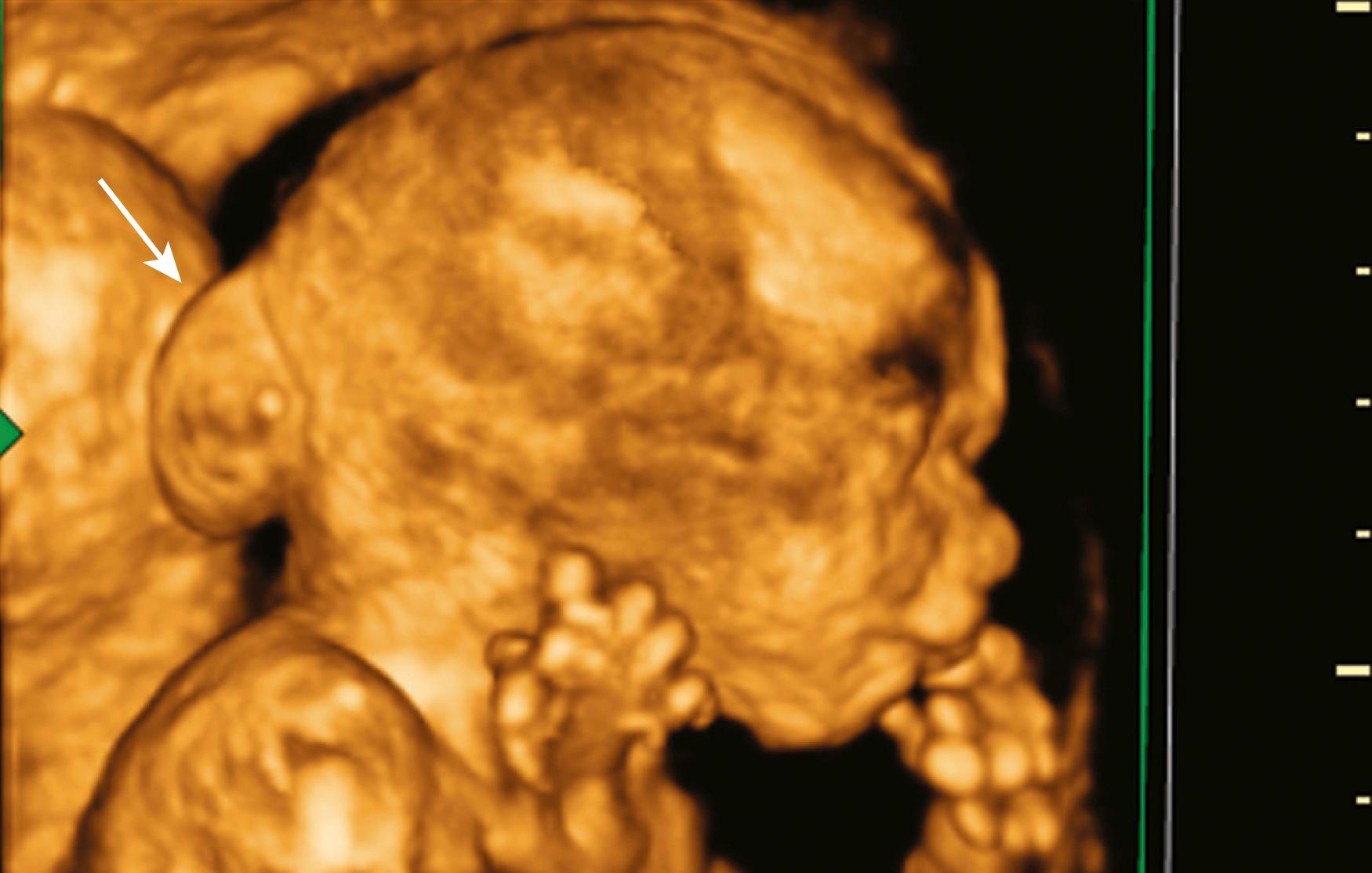
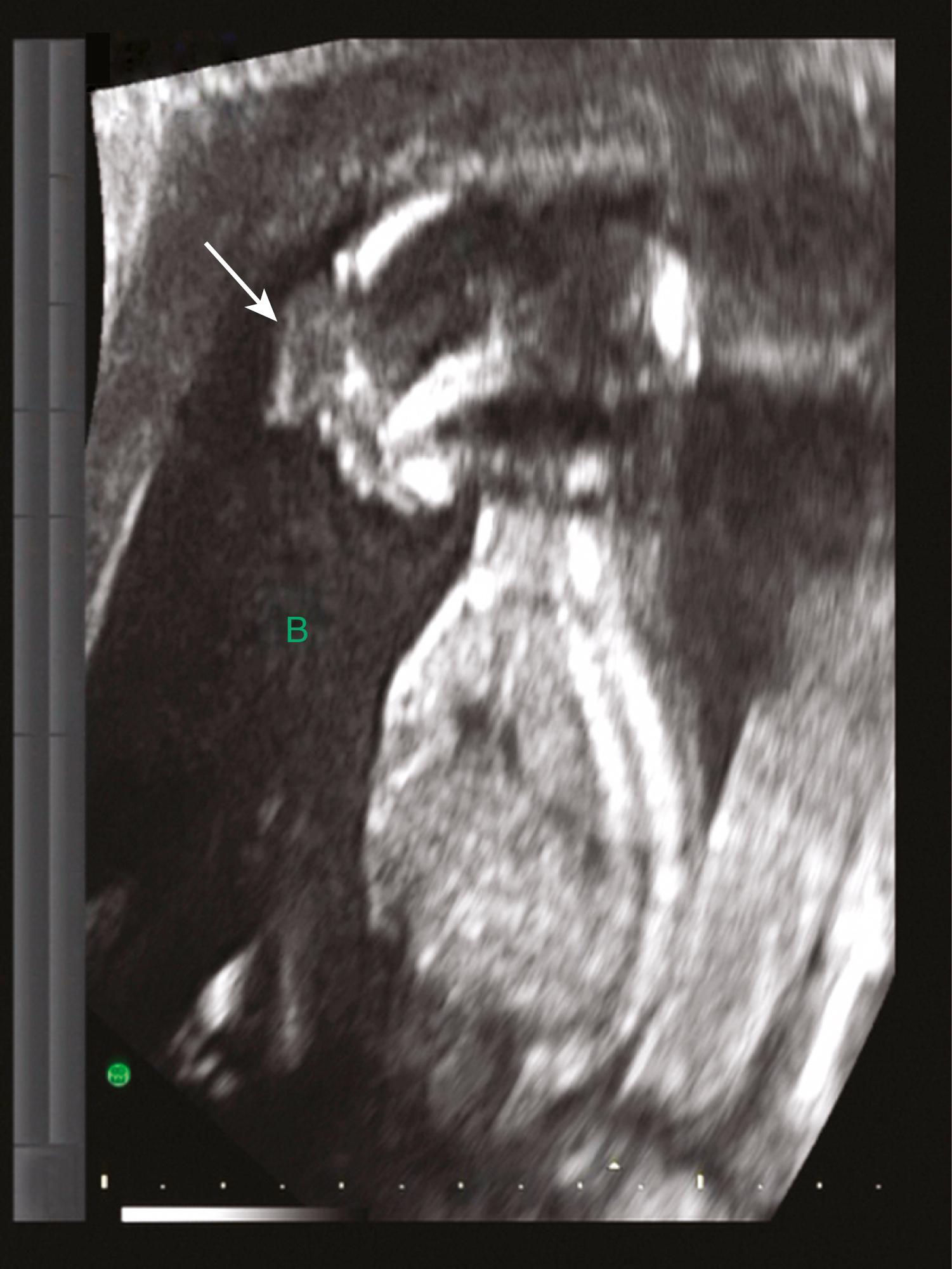
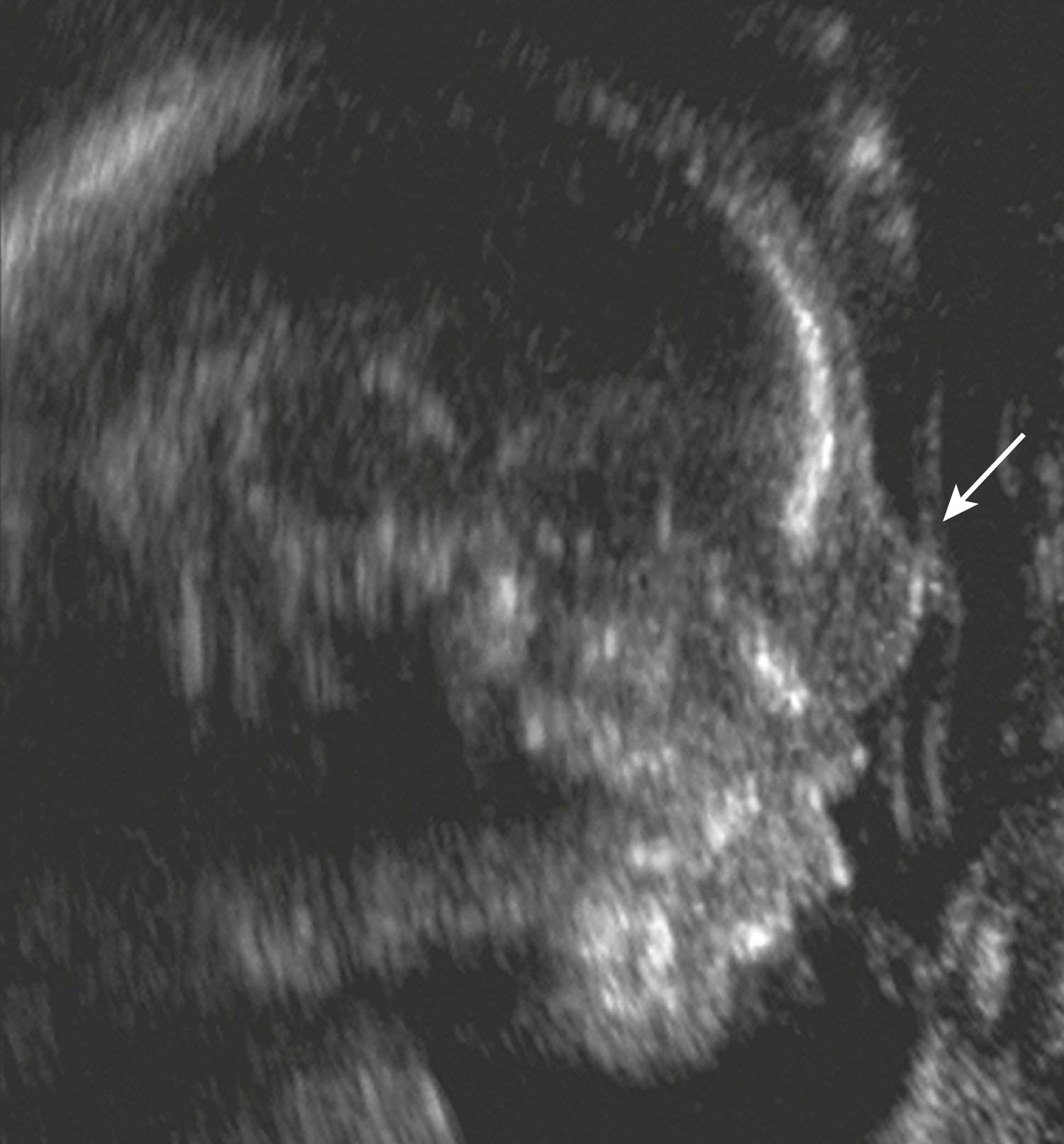
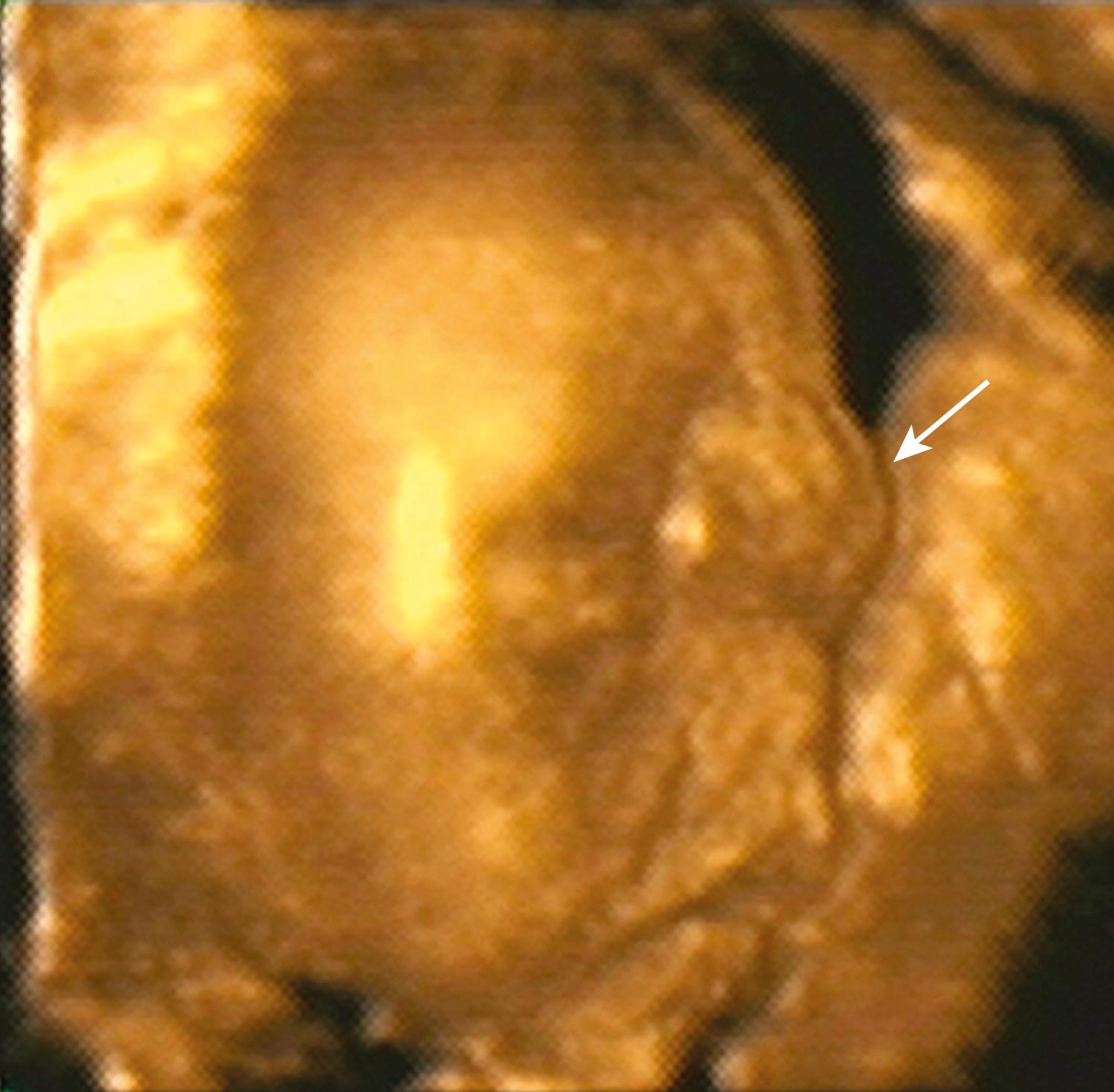
Detailed anatomic survey, fetal echocardiography.
Genetic counseling, chorionic villus sampling (CVS), or amniocentesis; may consider microarray if chromosomes are normal.
Consultation with maternal-fetal medicine, pediatric neurosurgery, pediatric neurology, and neonatology.
Consider MRI if diagnosis not clearly established by ultrasound.
Offer termination of pregnancy.
Repeat ultrasound during third trimester.
Delivery in a tertiary care hospital.
Delivery route needs to be individualized after consultation with appropriate specialists, such as maternal-fetal medicine, neonatology, pediatric neurology, and neurosurgery.
Depends on presence of associated anomalies, size and contents of the cephalocele.
Postnatal surgical resection and closure of defect.
High mortality rate—80% in prenatally diagnosed cases.
Among survivors: normal development in 48%, mild developmental delay in 11%, moderate developmental delay in 16%, severe developmental delay in 25%, and death in 5%.
Meckel syndrome and Walker-Warburg syndrome have a poor prognosis with a significant number of fetuses stillborn or dying shortly after birth.
In Knobloch syndrome, severe visual deficits eventually leading to blindness.
Normal intelligence has been reported.
Choroid plexus cysts (CPCs) are well-demarcated, anechoic, fluid-filled structures within the choroid plexus of the lateral ventricles of the brain. They are not true cysts in the pathologic sense. CPCs are often called “soft sonographic signs” or “markers” of aneuploidy because some studies have found an association between them and fetal chromosomal abnormalities. However, as more knowledge has accumulated, the initial importance attributed to this common sonographic finding has diminished. When CPCs are isolated, some consider them an anatomic variant. ,
Incidence is 0.18%–3.6% of fetuses scanned in second trimester. , ,
Pathogenesis is not clear but may be caused by filling of neuroepithelial folds with cerebrospinal fluid. CPC results from fluid trapped within this spongy layer of cells.
Unilateral or bilateral sonolucent cystic structures within glomus of choroid plexus of the lateral ventricles.
Well-delineated borders.
Size, shape, and number variable; heterogeneous appearance.
Usually small, measuring <10 mm in diameter (range, 3–20 mm); should be at least >2 mm to meet criteria. Therefore, not every “dropout” seen in the choroid plexus is a true CPC.
They regress, spontaneously disappearing during third trimester. , ,
Ventriculomegaly
Choroid plexus papilloma
Intraventricular hemorrhage
Periventricular leukomalacia
CPCs may be an isolated finding or associated with fetal anomalies.
Associated anomalies are typically those seen with trisomy 18 and include congenital heart disease, clenched hands, single umbilical artery, intrauterine growth restriction, and rocker-bottom feet.
Chromosomal aneuploidy: trisomy 18.
Rare cause of obstructive hydrocephaly.

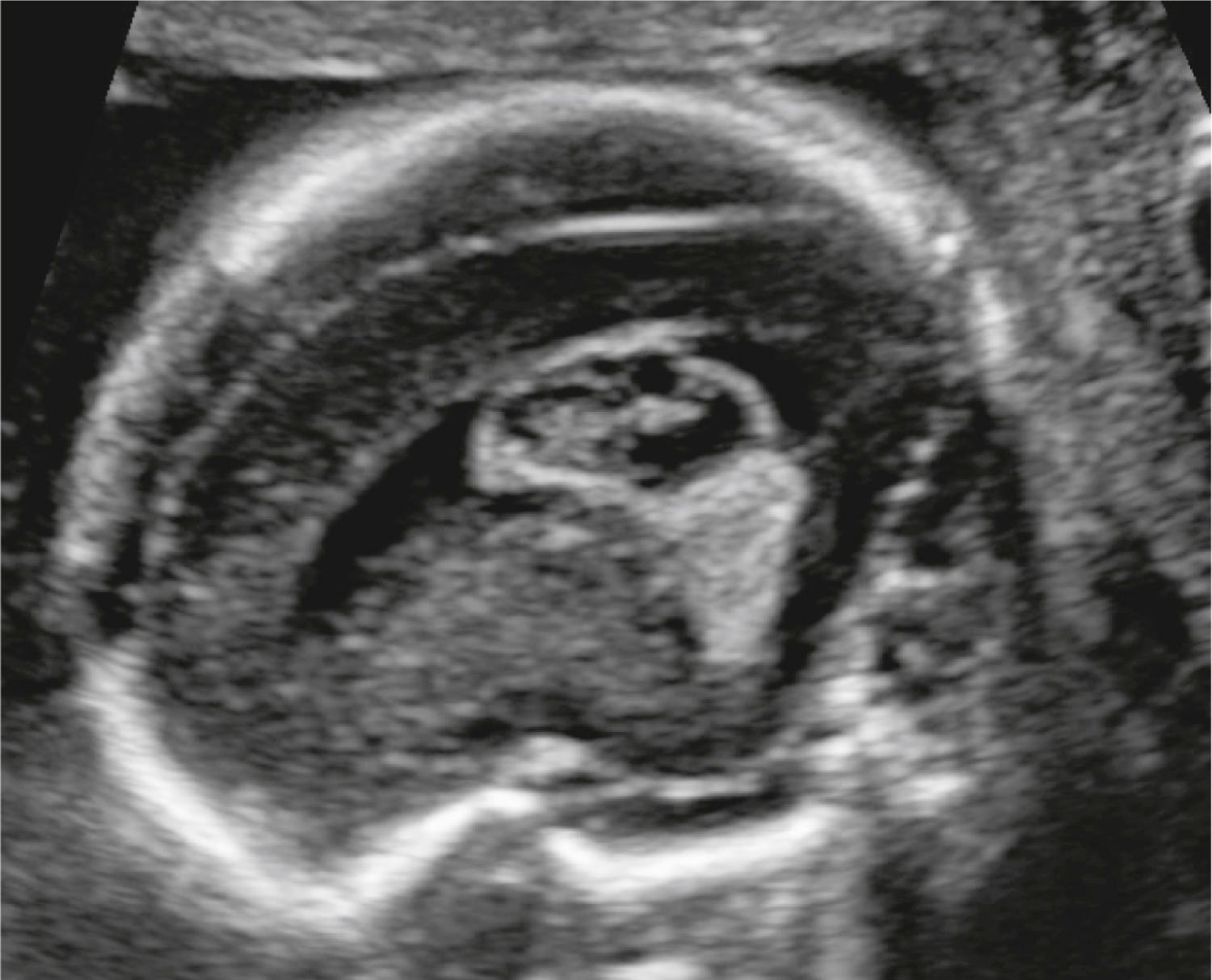
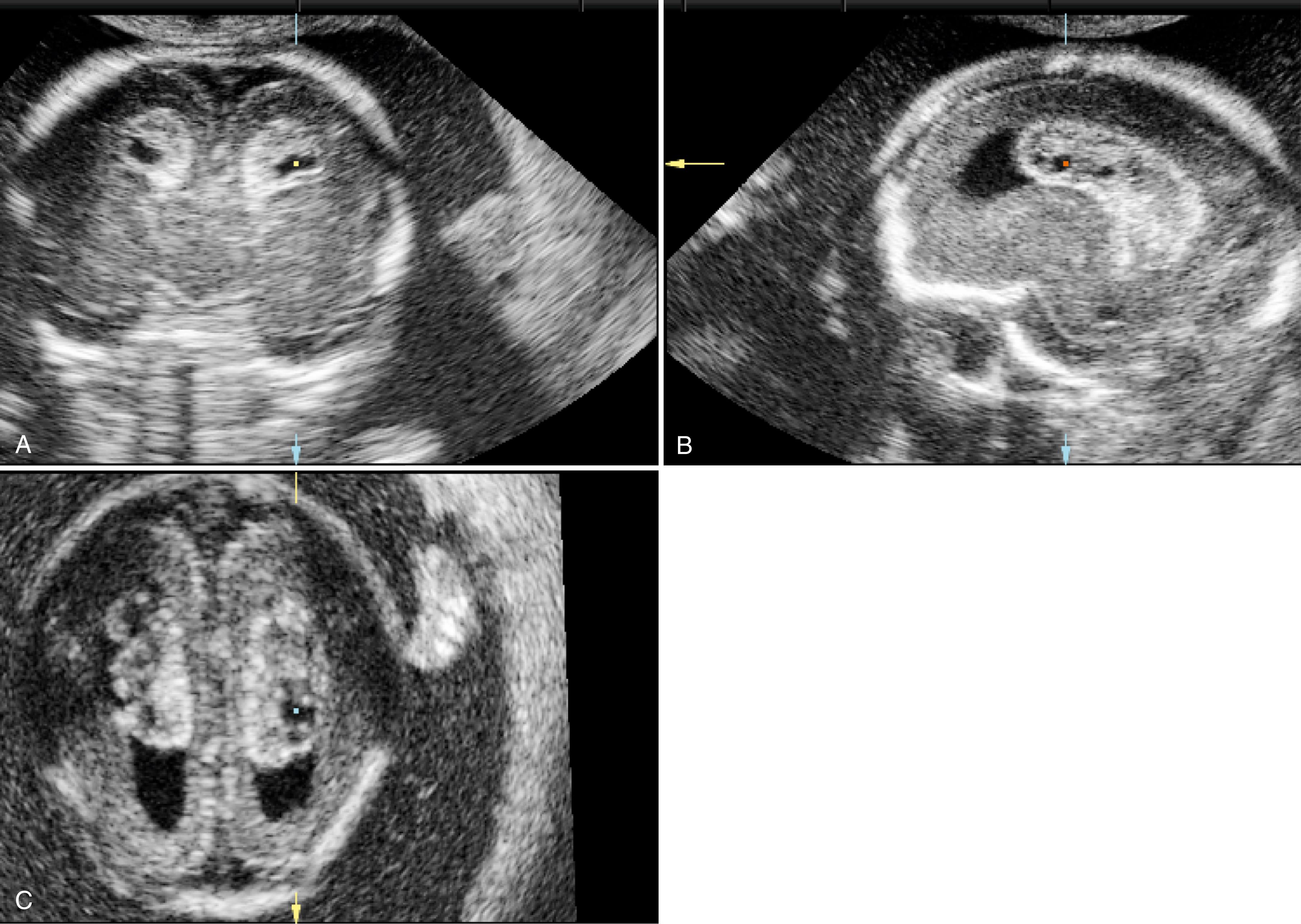
Anatomic survey: document bilateral open hands, normal fetal cardiac views, and three vessels in umbilical cord.
Consider fetal echocardiography if unable to adequately image fetal heart, but not required routinely.
Maternal serum screen, if not already done, or review first-trimester nuchal translucency (NT) screen result. Consider noninvasive prenatal testing (NIPT).
If CPCs are isolated findings and available aneuploidy screening suggests low risk of trisomy 18, especially if screening was by cell-free fetal DNA, couple can be counseled that amniocentesis is unlikely to find any abnormality.
If CPCs are associated with other findings (e.g., ventricular septal defect [VSD], clenched hands) or aneuploidy screen shows increased risk, offer genetic counseling and amniocentesis.
After normal fetal anatomy is established, no sonographic follow-up is considered necessary because isolated and non-isolated CPCs resolve spontaneously.
Further sonography is not necessary except in cases of severe parental anxiety.
In patients with isolated CPC, routine obstetric management is indicated.
Cesarean delivery only for usual obstetric indications.
If associated with other findings, delivery method may be dictated by concurrent fetal anomaly.
No special management is necessary for neonates who had isolated CPCs as fetuses.
If there are other anomalies, management of the neonate is dictated by the findings.
If trisomy 18 is present, provide comfort care, genetic consultation, and perinatal hospice if available.
The prognosis of isolated CPC is good; almost all resolve by 32 weeks. , ,
Isolated CPCs in fetuses with normal karyotypes do not affect child development after birth.
Guarded prognosis if associated with anomalies, depending on results of karyotyping and/or severity of associated anomalies.
The concurrent anomaly dictates the prognosis.
Holoprosencephaly (HPE) encompasses a spectrum of brain abnormalities in which there is failure of the forebrain to properly divide along the midline. The three classic forms are alobar, semilobar, and lobar; a fourth mild form, middle interhemispheric variant (MIHV), is also recognized. In alobar HPE, the most severe type, there is complete lack of division of the forebrain with absent midline structures. In semilobar HPE, there is some posterior separation. In lobar HPE, there is lack of separation of the ventral neocortex and agenesis of the corpus callosum. In MIHV, the mildest form, failure of separation involves the posterior frontal and parietal lobes, with incomplete separation of the thalami and caudate nuclei and absent body of the corpus callosum. HPE is associated with a spectrum of facial abnormalities, with more severe abnormalities seen with the most severe type (i.e., alobar).
HPE is the most common malformation involving the forebrain. It occurs in 1:250 embryos and 1:10,000 live births. It is estimated that spontaneous demise and abortion will occur in >90% of affected embryos.
HPE is a primary defect of induction and patterning that leads to partial or complete failure of division of the prosencephalon into two separate hemispheres between 18 and 28 days after conception. However, no splitting actually occurs; instead, there is budding of the telencephalon.
Genetic and environmental factors play a role in development of HPE.
In alobar HPE, there is a monoventricle; absence of the interhemispheric fissure, falx cerebri, corpus callosum, and cavum septi pellucidi; fusion of the thalami and cerebral hemispheres; and possibly various facial anomalies (e.g., cyclopia, proboscis, median clefts). In the first trimester (11 0/7–13 6/7 weeks), there is failure to image the two choroid plexuses (“butterfly” appearance) in the axial plane.
In semilobar HPE, there is absence of the interhemispheric separation, but posteriorly there is some separation. The anterior horns are fused; the septi pellucidi and the anterior part of the corpus callosum are absent; and there is partial separation of the thalami, a rudimentary third ventricle, and facial anomalies (e.g., hypotelorism).
In lobar HPE, there is absence of the cavum septi pellucidi and corpus callosum in the affected area.
In MIHV, there is incomplete separation of the thalami and caudate nucleus, absent body of the corpus callosum, and brain heterotopias.
Microcephaly is commonly seen.
In alobar and semilobar HPE:
Hydrocephaly
Schizencephaly
Arachnoid cyst
Agenesis of the corpus callosum
In lobar HPE:
Septo-optic dysplasia
In middle interhemispheric variant (MIHV):
Dysgenesis of the corpus callosum
CNS abnormalities: most commonly neural tube defects (exencephalies, meningoencephaloceles, myelomeningoceles, and myeloceles), Dandy-Walker malformation (DWM), rhombencephalosynapsis.
Facial abnormalities seen with the most severe cases may include cyclopia, synophthalmia, or microphthalmia; proboscis; severe hypotelorism; midline cleft lip and palate; flat nasal bridge; and single or barely separated nostrils. ,
25%–45% of newborns with HPE have a karyotype abnormality (trisomy 13, trisomy 18, triploidies). Mutations in 21q22.3, sonic hedgehog ( SHH ), Zic2 , SIX3 , and TGIF genes are also seen.
About 25% have syndromes such as Smith-Lemli-Opitz and Pallister-Hall syndromes.
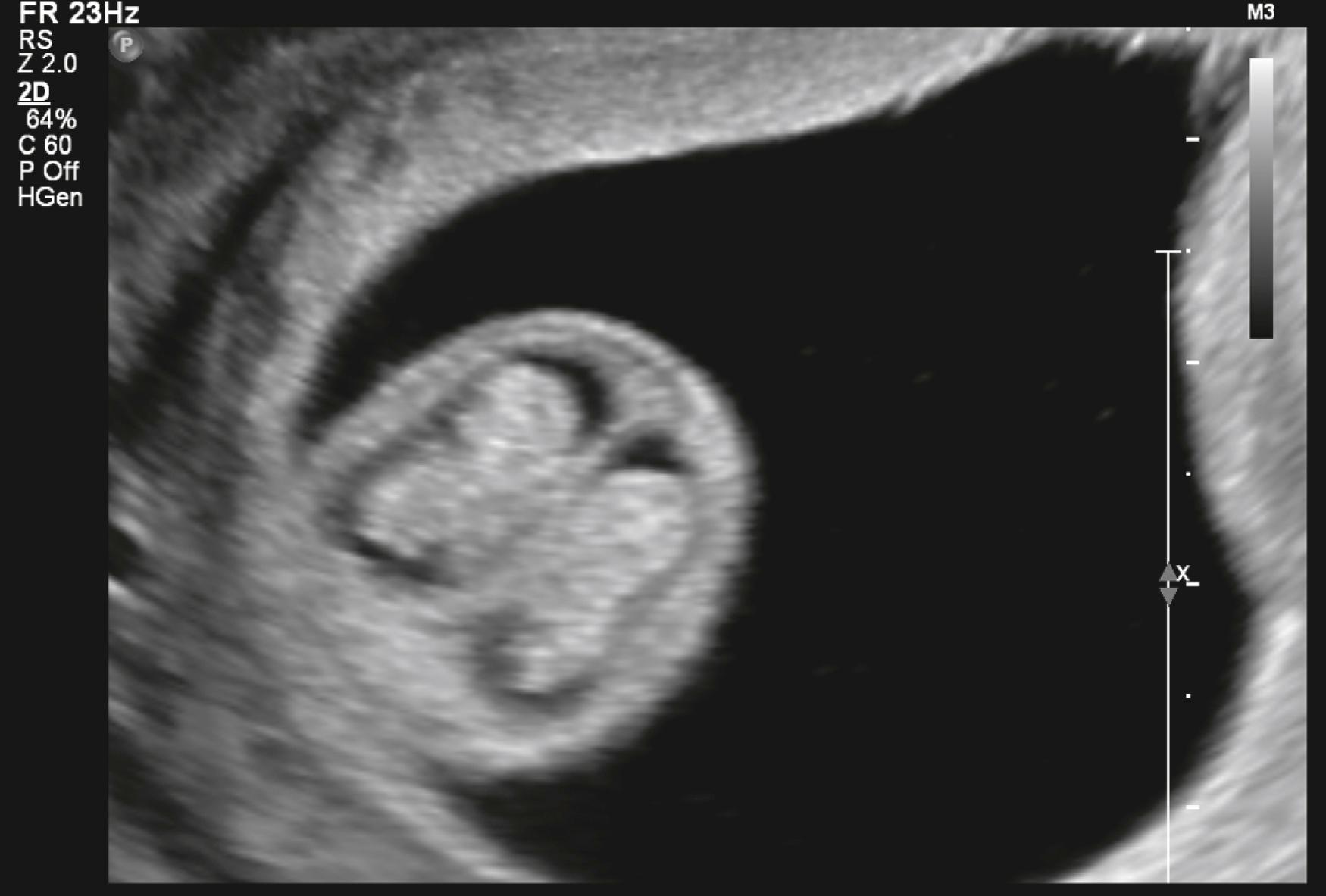
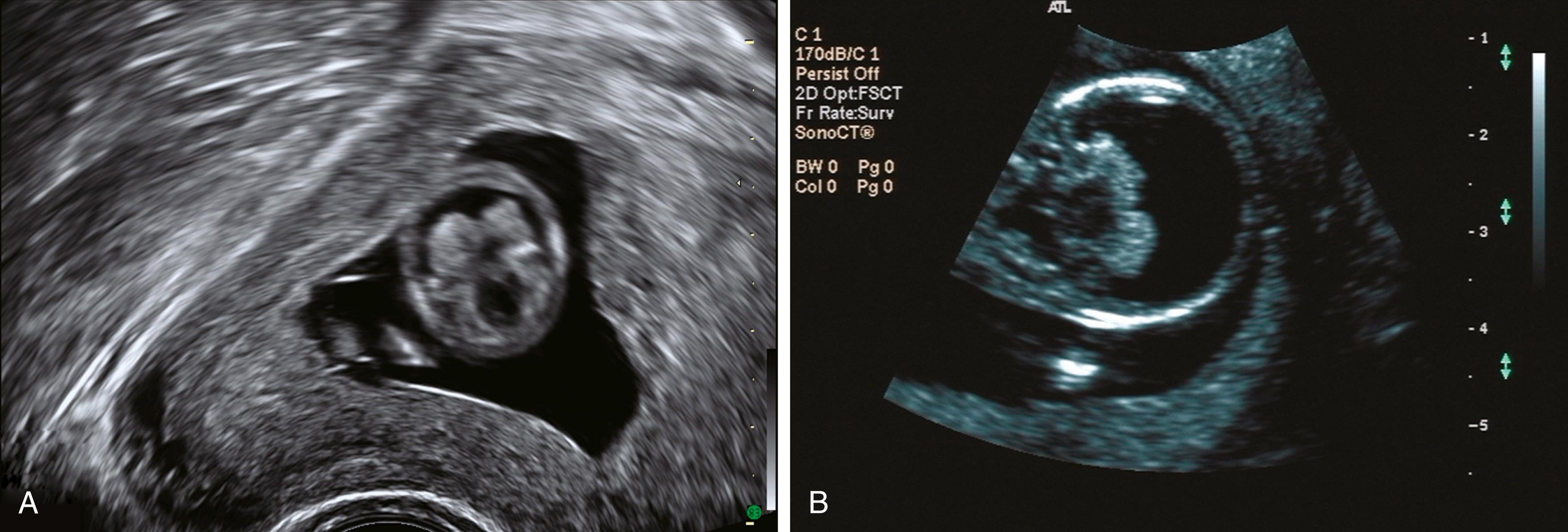
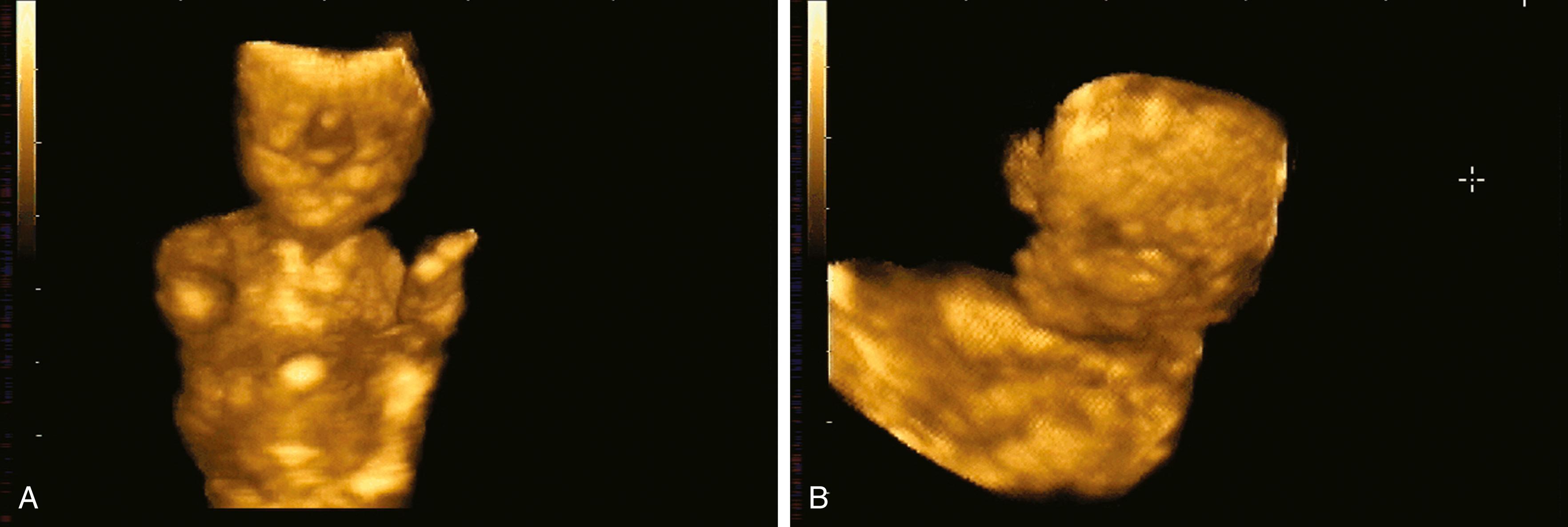
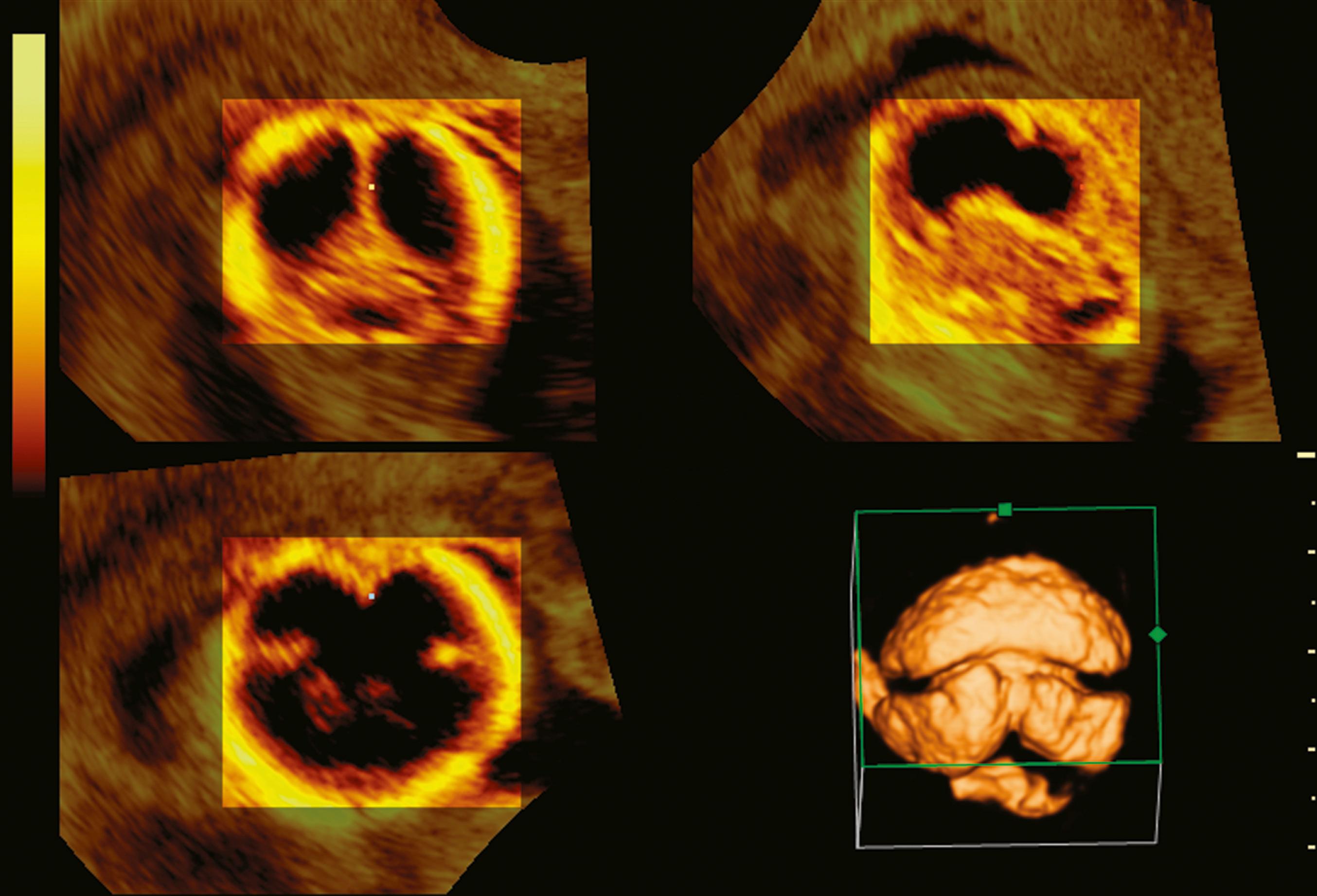
Anatomic survey, fetal neurologic scan, consider 3D imaging to assess degree of facial abnormalities, fetal echocardiography.
Offer genetic counseling, karyotyping, and microarray studies.
Consultations with neonatology, pediatric neurology, and genetics are suggested.
Offer termination of pregnancy.
In lobar form of HPE and in ongoing pregnancies, consider fetal MRI to better define the brain anomaly and look for gray matter abnormalities.
In ongoing pregnancies, repeat scan in third trimester.
Delivery should be at institution with a neonatal intensive care unit (NICU) as well as services such as pediatric neurology, genetics, and radiology.
Vaginal delivery is not contraindicated. Delivery route should be individualized depending on the severity of the brain and facial abnormalities. In alobar HPE, if macrocephaly or severe hydrocephaly is present, consider cephalocentesis.
In milder forms of HPE, cesarean delivery should be performed for the usual obstetric indications. In alobar HPE, cesarean section should be offered only for maternal indications.
For newborns with the most severe brain anomalies and facial dysmorphism, supportive and comfort care should be given owing to the high mortality rate.
Refer parents to perinatal hospice program, if available.
In neonates with milder forms of HPE, consultation with genetics and neurology and repeat brain ultrasound and/or MRI are recommended to reassess in utero findings.
Karyotyping and/or chromosomal microarray testing should be performed if not previously done.
Mortality rate for neonates with HPE is high. Some survive beyond the neonatal period, and a small number survive for many years. Approximately 33% die within the first day, and 58% die within the first month; only 29% survive 1 year.
Survival depends on severity of brain and facial abnormalities, the presence of aneuploidy, and other congenital anomalies.
Alobar HPE has the highest mortality; however, children with milder forms of HPE (lobar and MIHV) may live for many years. Isolated HPE has the best survival; 54% of affected children live beyond the first year.
All children with HPE have developmental disabilities. The degree of developmental disability typically correlates with severity of brain malformation. Alobar HPE has the worst neurologic outcome.
Porencephalic cyst is a pathologic brain cavity filled by cerebrospinal fluid (CSF); it is not a true cyst because it does not have a cyst wall. The cyst is the end result of an insult occurring between the second trimester of pregnancy and the early postnatal period. Areas affected by the insult undergo tissue necrosis and resorption, leaving behind a cavity in the brain (porencephalic cavity). Schizencephaly and porencephaly may share similar pathologies.
Porencephaly is a rare disorder that is the end result of a prenatal or perinatal ischemic stroke caused by an arterial or venous infarction, intraparenchymal hemorrhage, or in utero infection. These insults result in focal or multifocal areas of brain necroses that subsequently undergo dissolution and cavity formation.
The fetal incidence is unknown; however, in term neonates the estimated incidence of a perinatal arterial ischemic stroke (PAIS) is 1:2500 to 1:5000.
Cyst or cavity within the brain parenchyma that communicates with the ventricles and/or subarachnoid space
Ventriculomegaly on the same side as cyst
No mass effect present
Cyst seen along distribution of the middle cerebral artery or other arteries
Typically seen late in gestation
Unilateral schizencephaly
Arachnoid cysts
Hydranencephaly
Ependymal cyst
Encephalomalacia
Brain tumor
Ventriculomegaly.
Polymicrogyria may border cysts.
Thrombophilias—high rate compared with general population.
In one study, 64% of infants with perinatal arterial stroke had at least one thrombophilic marker, and 68% of the mothers were carriers of a thrombophilia.
Factor V Leiden mutation, protein C deficiency, and presence of antiphospholipid antibodies were significant factors for perinatal stroke.
Mutation in collagen IV A1 (COL4A1) gene in autosomal dominant porencephaly.
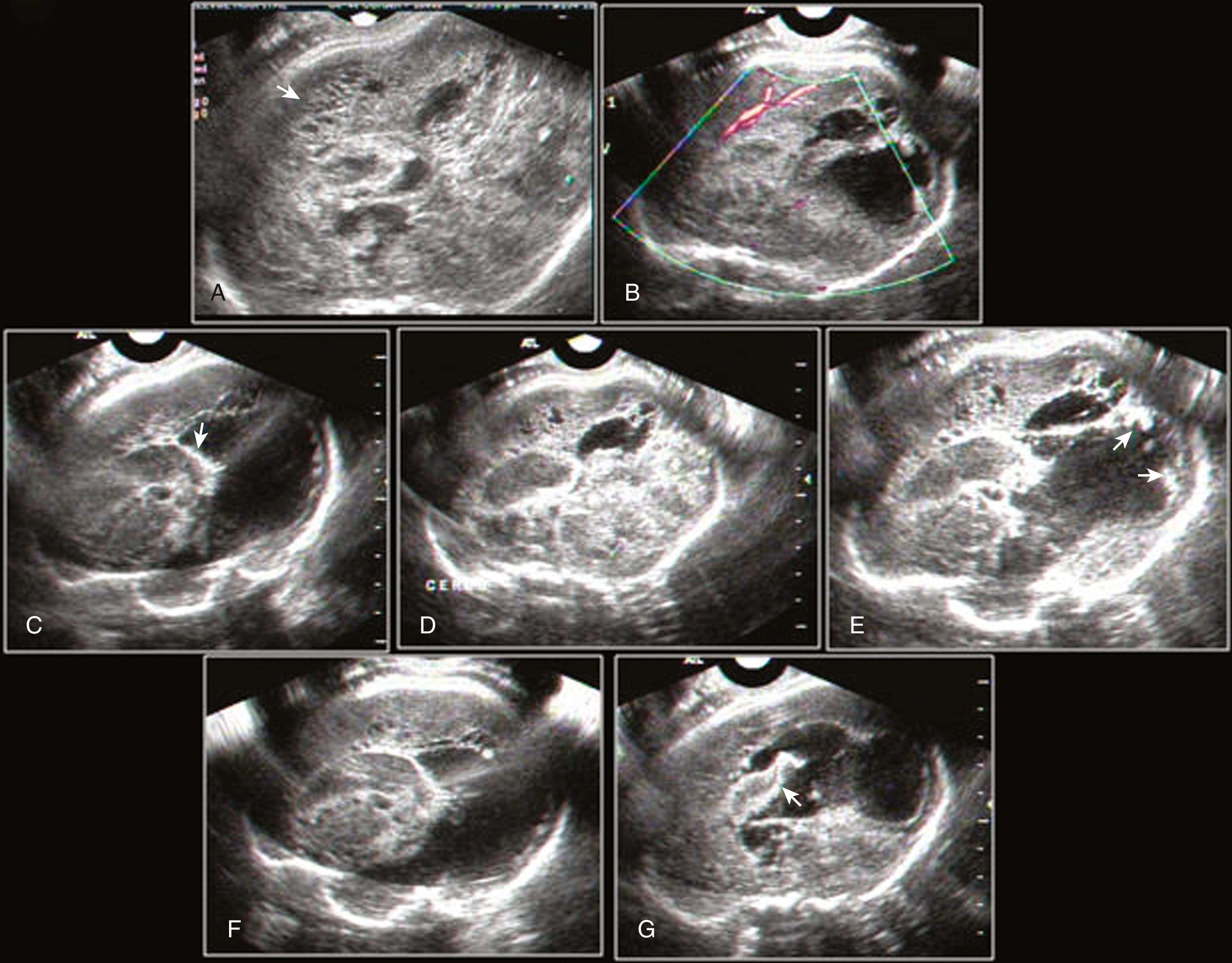
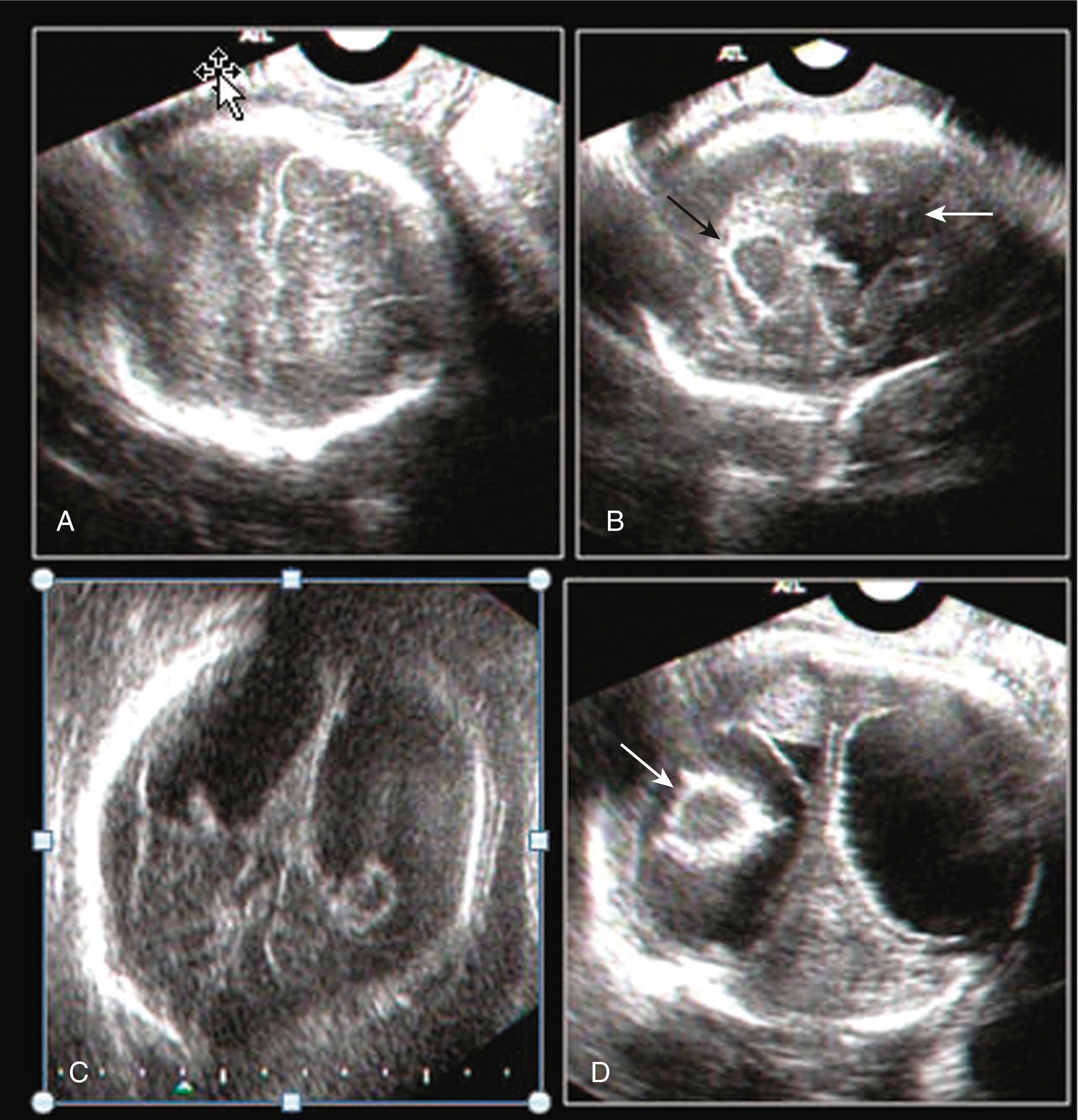
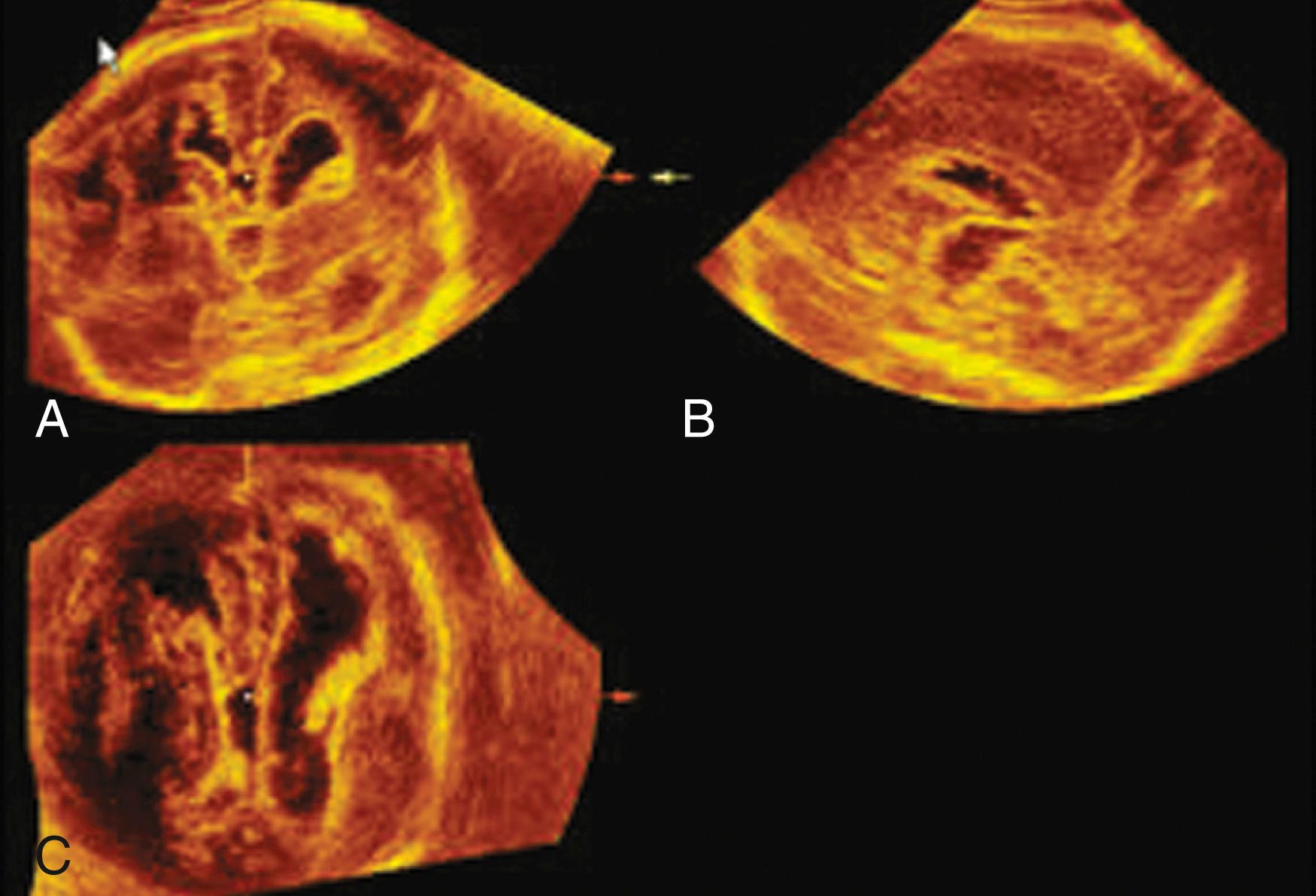
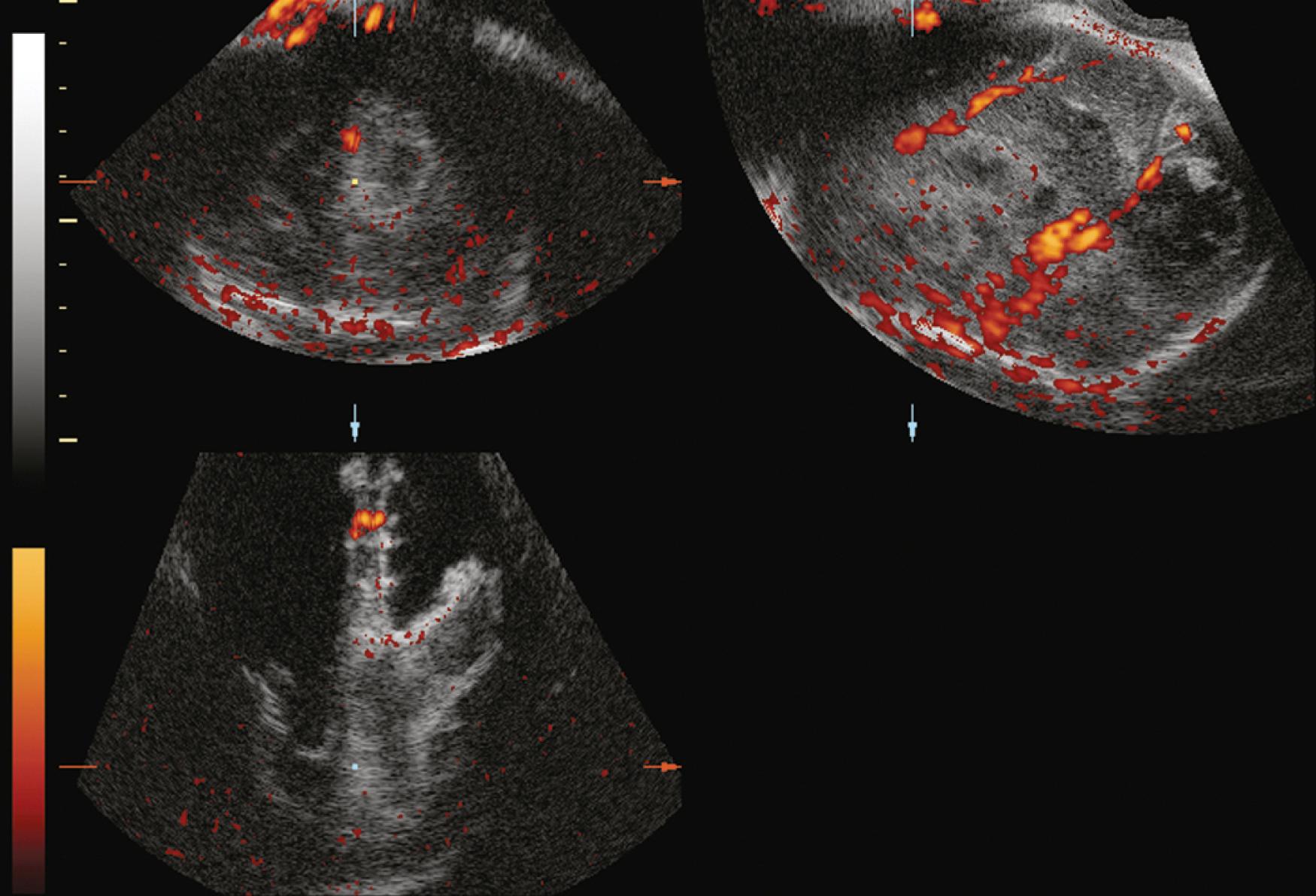
Detailed anatomic survey and fetal neurologic scan.
Genetic counseling and testing.
Thrombophilia workup of both parents (factor V Leiden mutation, protein C deficiency, antiphospholipid antibodies).
Fetal infection workup (TORCH [ t oxoplasmosis, o ther agents, r ubella, c ytomegalovirus, and h erpes simplex] titers, Zika virus if living in an area with active transmission).
Consultations with neonatology, pediatric neurology, and neurosurgery.
Fetal MRI to look for other intracavitary and extracavitary anomalies.
Offer termination of pregnancy.
For ongoing pregnancies, perform ultrasound to monitor ventriculomegaly.
No standard recommendations for best route of delivery.
Given poor long-term prognosis, vaginal delivery should be offered.
Cesarean delivery should be performed for routine obstetric indications.
At birth evaluation by neonatologist; may need NICU admission.
Imaging studies such as ultrasound and MRI to confirm diagnosis and search for additional anomalies.
Evaluation by geneticist to exclude familial porencephaly.
Neurology and neurosurgery consultations.
Evaluation and control of seizures, which may begin shortly after birth.
Shunt if severe or progressive hydrocephaly.
Porencephaly is associated with considerable morbidity and mortality. The prognosis varies according to the location, extent of the lesion, and timing of the insult. Most prenatally diagnosed cases have a poor outcome.
Among survivors, porencephaly is a leading cause of cerebral palsy and congenital hemiplegia.
Hemiparesis and/or motor deficits are seen in >80%.
50%–75% have neurologic deficits or epilepsy.
20%–60% have deficits in language, vision, cognition, and behavior.
A small number of children have mild to no neurologic symptoms.
The terms ventriculomegaly (VM) and hydrocephaly are used interchangeably in the literature, but they are different entities. Ventriculomegaly should be preferred because it identifies the abnormal sonographic finding independently from the etiology. Most commonly, ventriculomegaly is used when the ventricles are mildly enlarged, and hydrocephaly is used when they measure >15 mm. Aqueductal stenosis (AS) results from the narrowing of the aqueduct of Sylvius, which connects the third and fourth ventricles.
The incidence of congenital dilation of the lateral ventricles is 3–15:10,000 births.
AS is the most common cause of fetal VM, accounting for 30%–40% of cases.
The aqueduct may become stenotic as a result of mass effect or from intrinsic pathology.
In approximately 75% of patients, the etiology of the disorder is not known (idiopathic AS). , Causes of AS include genetic (X-linked or L1) syndromes, MASA syndrome ( m ental retardation, a phasia, s huffling gait, a dducted thumbs), and spastic paraplegia 1 (SPG1) syndrome; bacterial and viral infections (e.g., cytomegalovirus [CMV], influenza A); hemorrhage (direct obstruction of aqueduct by blood or clot); and CNS anomalies (e.g., Chiari I, Dandy-Walker malformation). ,
Incidence of X-linked hydrocephaly is 1:30,000 males.
AS is a diagnosis of exclusion, and other causes of VM need to be ruled out.
Severe bilateral VM with lateral ventricles measuring >15 mm with dangling choroid plexus and dilation of third ventricle.
VM is usually progressive.
Macrocephaly.
The brain mantle may be thin or compressed.
The corpus callosum may be thin or undetectable because of compression from the dilated ventricles.
Agenesis of the corpus callosum.
Absent or fenestrated cavum septi pellucidi.
Posterior fossa structures (cerebellum, vermis, and cisterna magna) are normal.
Periventricular calcification if AS is caused by intracranial infection.
Hemorrhage or masses.
Abducted thumbs.
More common in male fetuses.
Holoprosencephaly
Porencephaly
Schizencephaly
Hydranencephaly
Extracranial abnormalities (30% of cases).
25% of cases have multiple anomalies.
Anomalies include macrocephaly, agenesis of the corpus callosum, and bilateral abducted thumbs (50%–60% of cases) (Online Mendelian Inheritance in Man [OMIM] database #307000).
Can be part of MASA syndrome.
Chromosomal aberrations (11% of cases).
L1CAM mutation.
In utero infection (e.g., CMV).
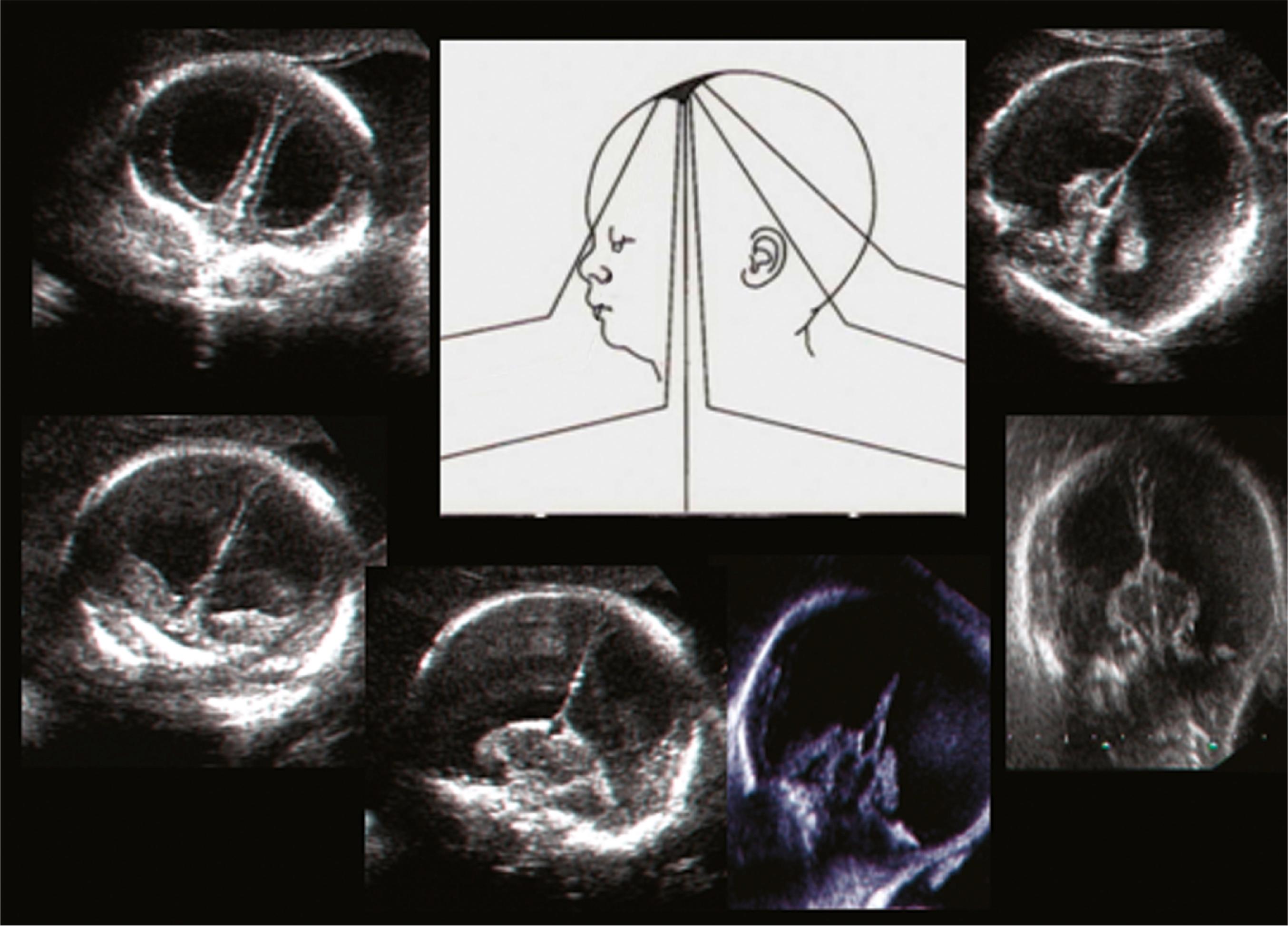
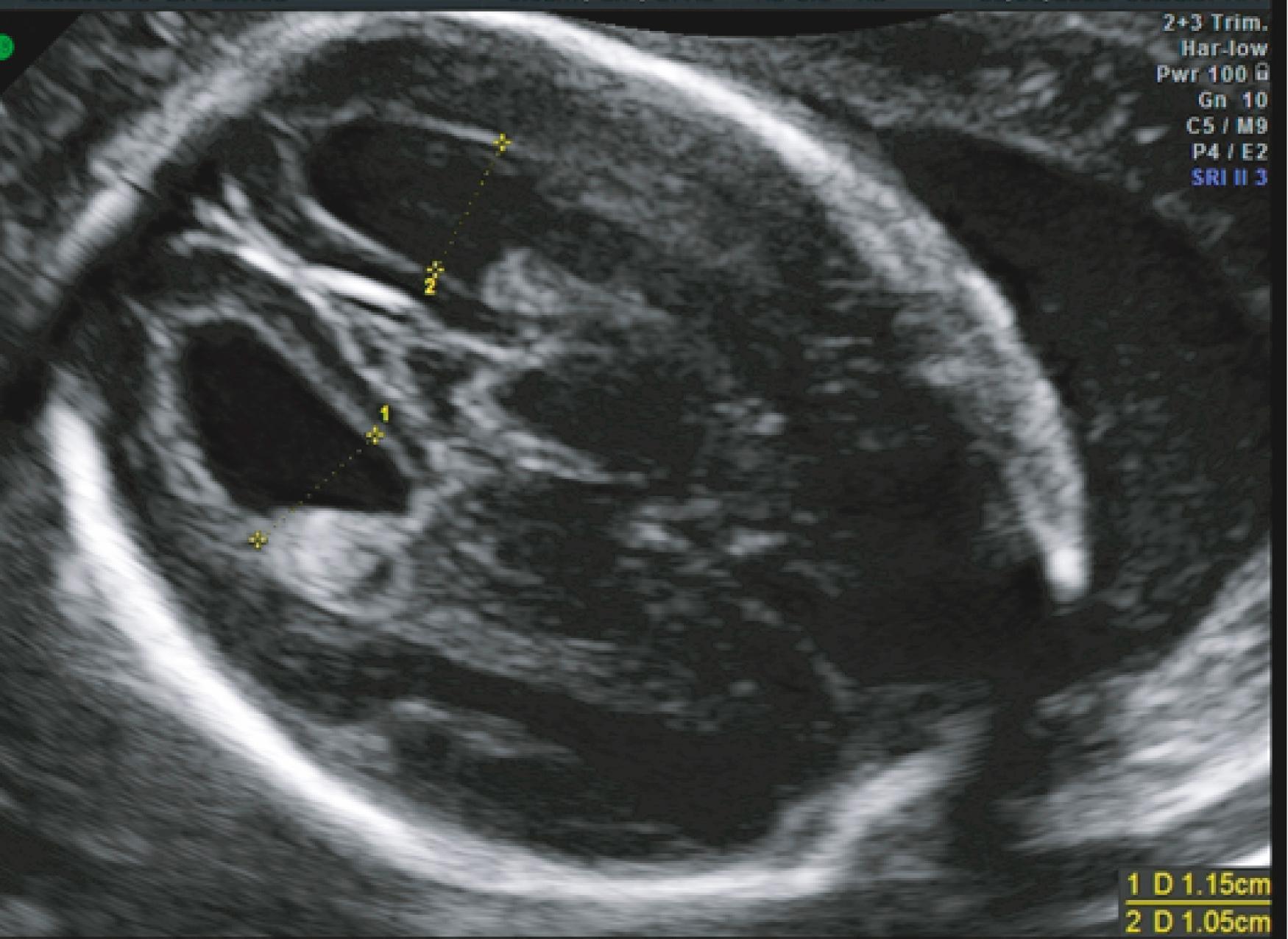
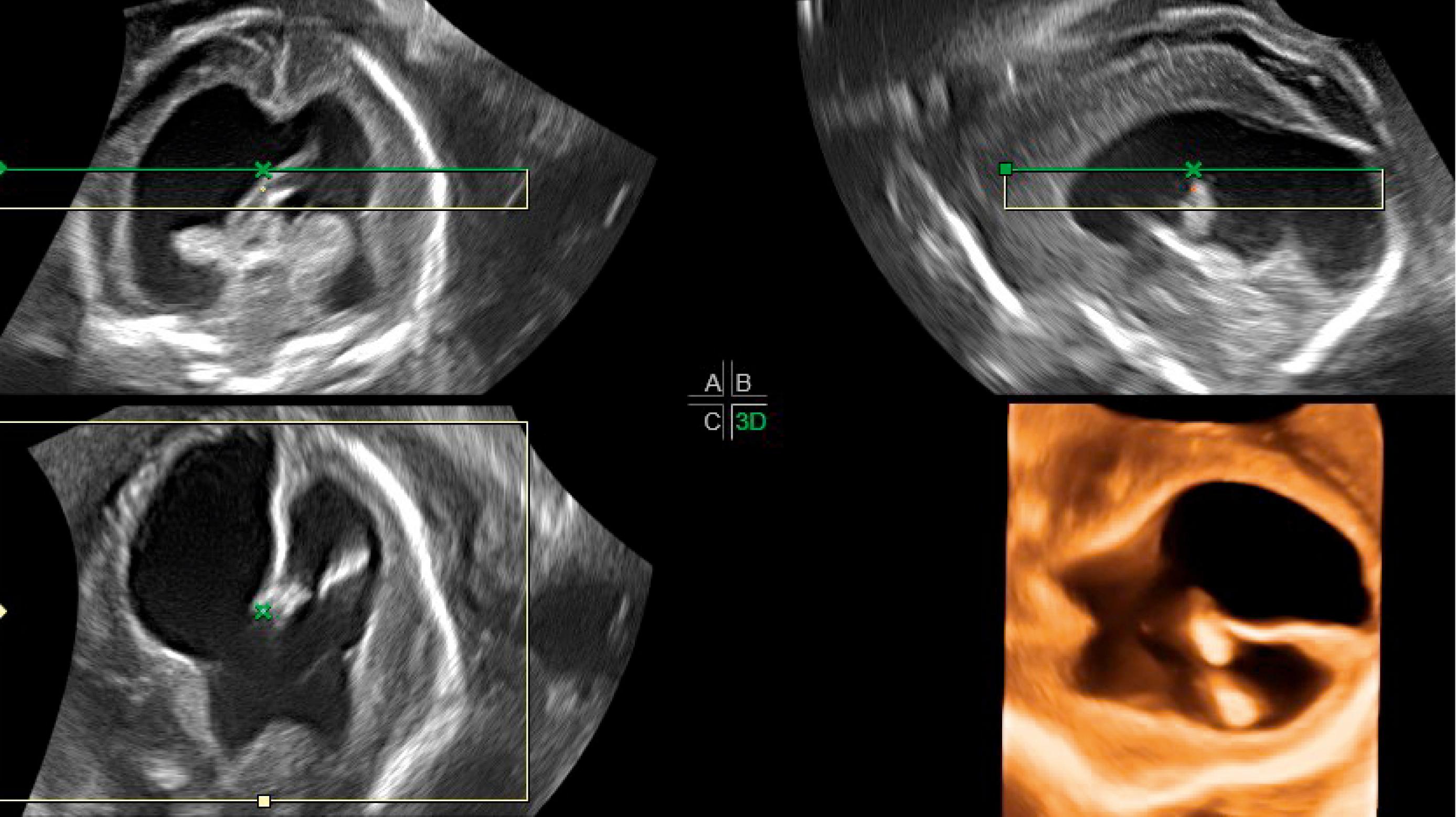
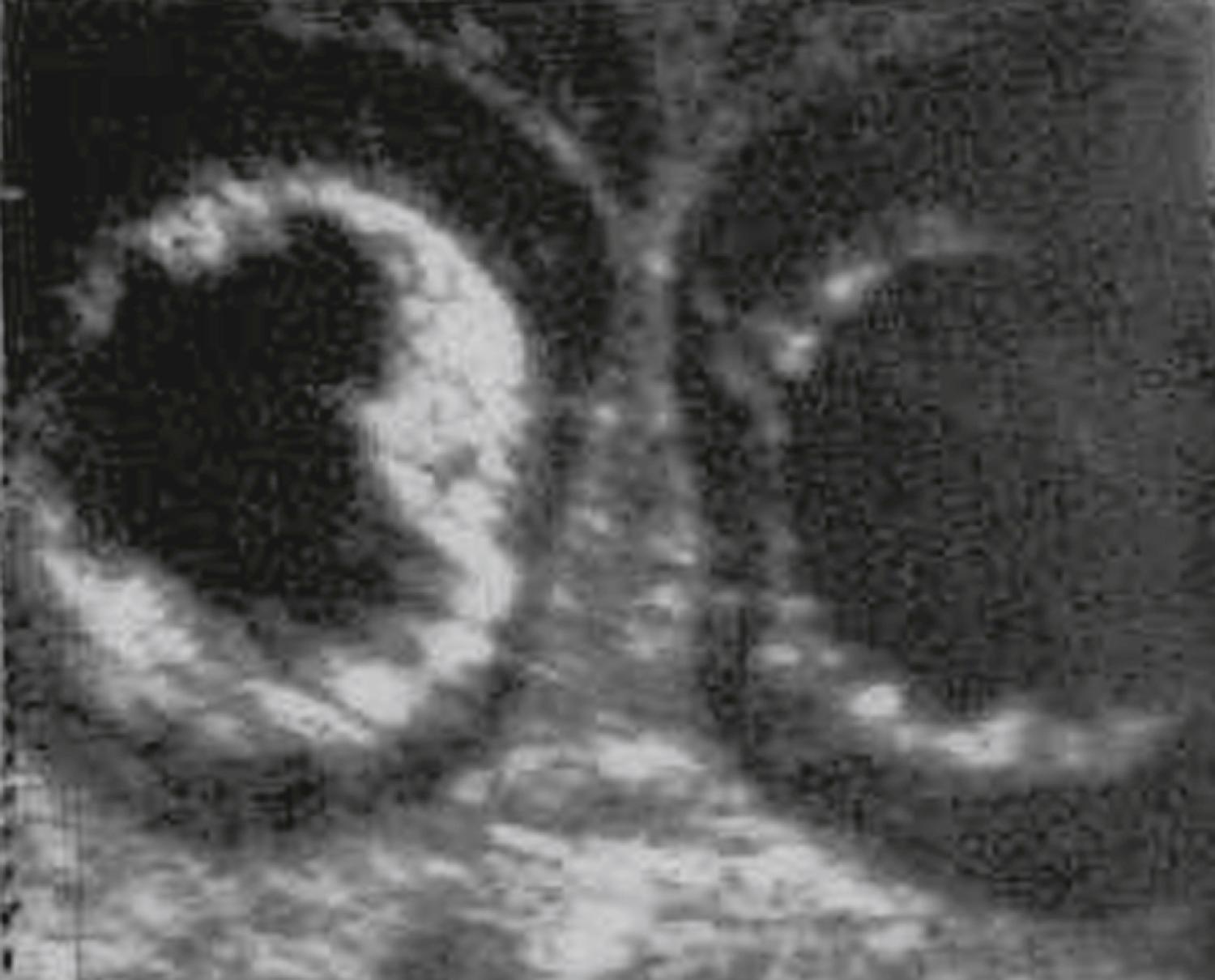
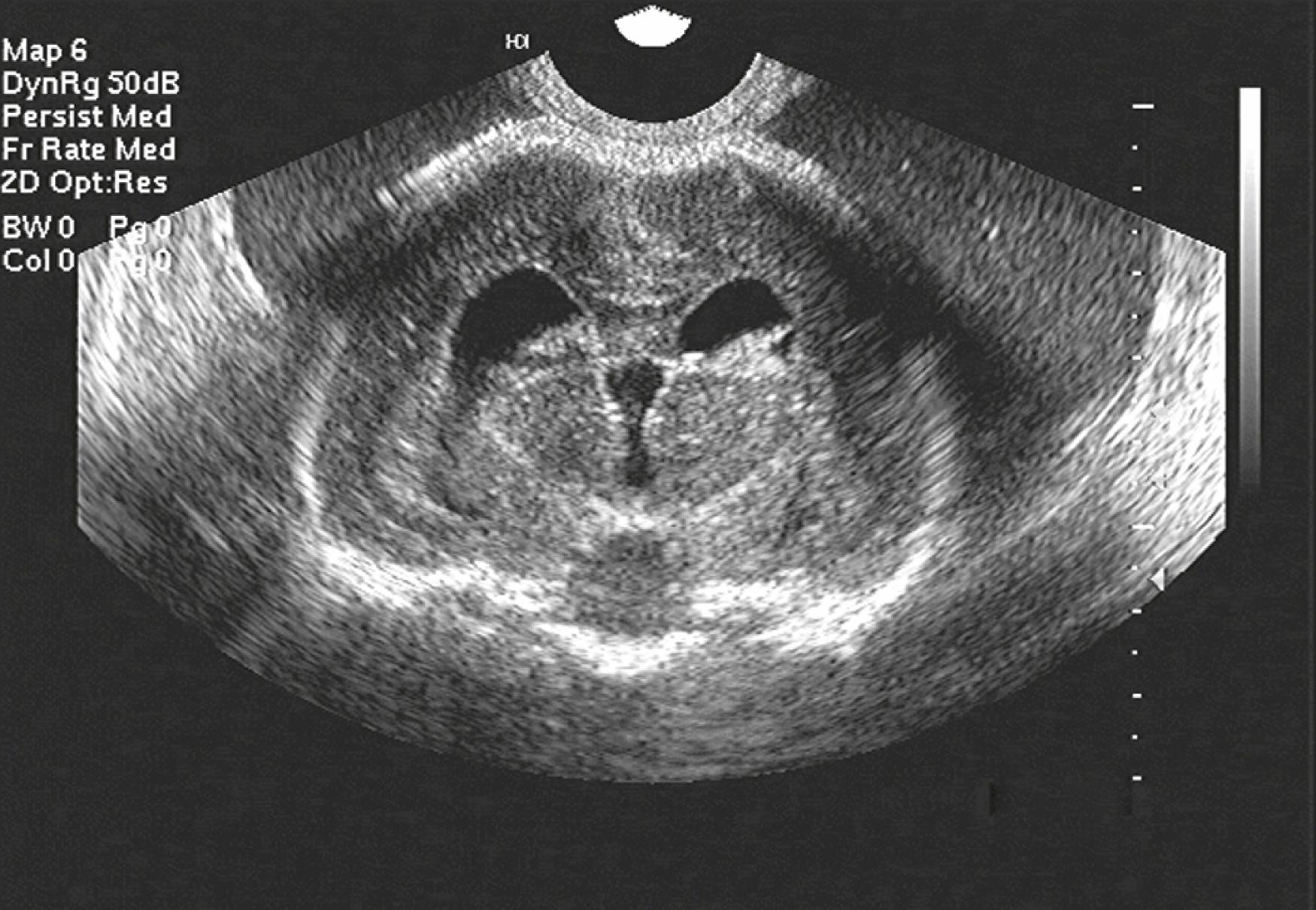
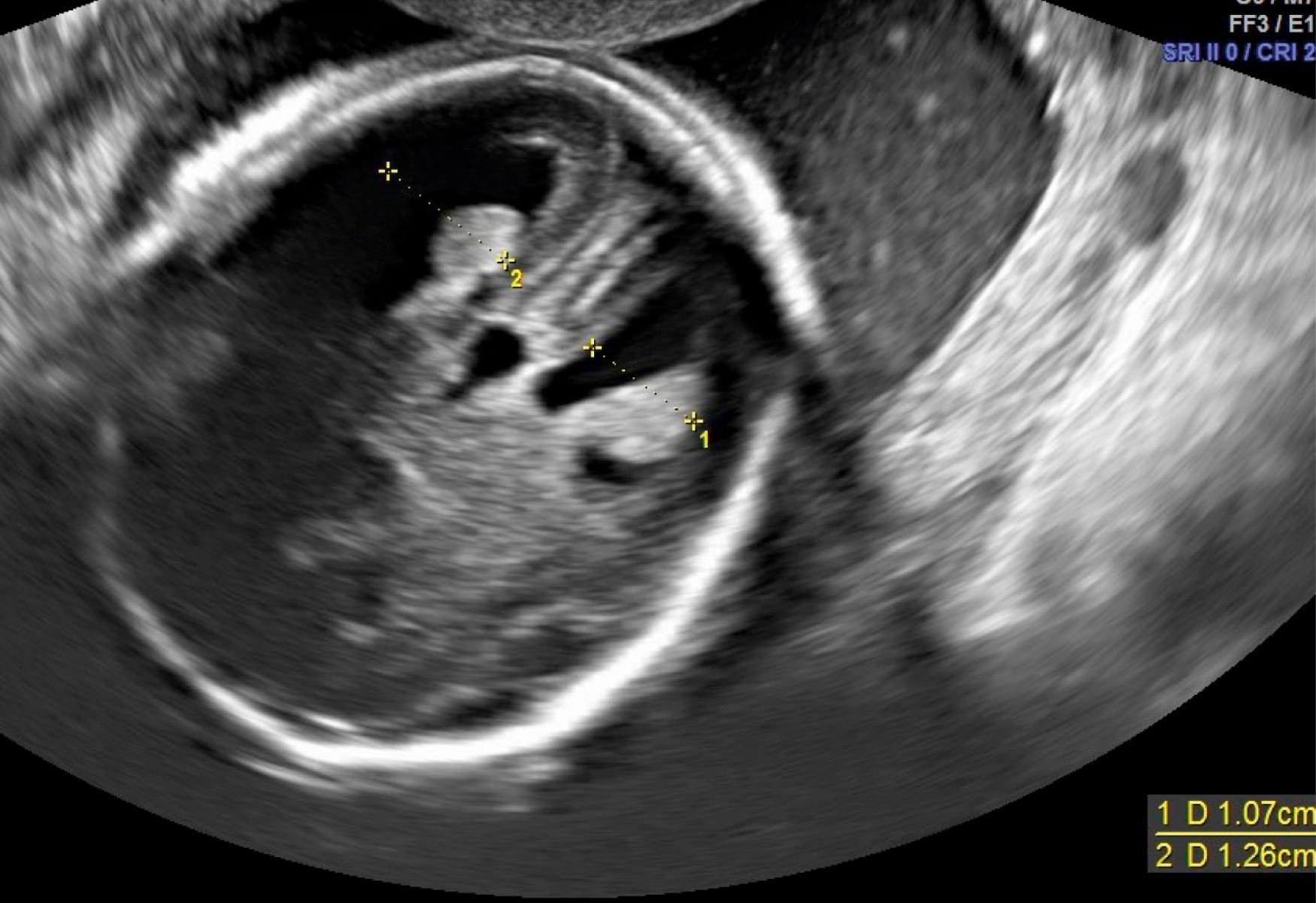
Become a Clinical Tree membership for Full access and enjoy Unlimited articles
If you are a member. Log in here